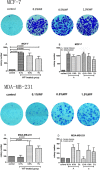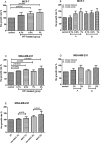High throughput screening of cytokines, chemokines and matrix metalloproteinases in wound fluid induced by mammary surgery
- PMID: 26313265
- PMCID: PMC4745727
- DOI: 10.18632/oncotarget.4828
High throughput screening of cytokines, chemokines and matrix metalloproteinases in wound fluid induced by mammary surgery
Abstract
Objective: To clarify the composition of wound fluid (WF) and investigate the impact of WF on breast cancer cell lines.
Methods: The proliferation and migration of WF-treated breast cancer cells MDA-MB-231 and MCF-7 were assessed with colony formation test, MTT cell proliferation test and scratch wound test. The quantitative profiles of WF were analyzed using Bio-Plex Pro kits.
Results: The proliferation and migration of WF-treated breast cancer cells were significantly higher than that of untreated cells. Fifteen cytokines, 29 chemokines and 9 matrix metalloproteinases (MMPs) were assessed in WF. The concentrations of these factors were influenced by post-surgery days, neoadjuvant chemotherapy (NAC), TNM stage, pathological type and molecular subtype. The WF harvested from patients underwent NAC showed significant higher profiles of interleukin-1β (IL-1β), IL-4, IL-6, IL-17F, IL-21, IL-23, IL-25, IL-31, Interferon γ (IFNγ), CD40 ligand (CD40L), tumor necrosis factor α (TNFα), CXCL1, CXCL2, CXCL5, CCL3, CCL7 and CCL20.
Conclusions: Surgery-induced WF promotes the proliferation and migration of breast cancer cells. The composition of WF is influenced by various clinical features and provides potential therapeutic targets to control local recurrence and tumor progression.
Keywords: breast cancer; proliferation; wound fluid.
Conflict of interest statement
All of the authors state no conflicts of interest.
Figures



Similar articles
-
Pro-inflammatory cytokine, matrix metalloproteinases and TIMP-1 are involved in wound healing after mastectomy in invasive breast cancer patients.Biomed Pharmacother. 2007 Oct;61(9):548-52. doi: 10.1016/j.biopha.2007.08.012. Epub 2007 Sep 14. Biomed Pharmacother. 2007. PMID: 17904786
-
Wound fluid enhances cancer cell proliferation via activation of STAT3 signal pathway in vitro.Oncol Rep. 2019 May;41(5):2919-2926. doi: 10.3892/or.2019.7047. Epub 2019 Mar 7. Oncol Rep. 2019. PMID: 30864735
-
Targeted intraoperative radiotherapy impairs the stimulation of breast cancer cell proliferation and invasion caused by surgical wounding.Clin Cancer Res. 2008 Mar 1;14(5):1325-32. doi: 10.1158/1078-0432.CCR-07-4453. Clin Cancer Res. 2008. PMID: 18316551
-
The ectoenzyme-side of matrix metalloproteinases (MMPs) makes inflammation by serum amyloid A (SAA) and chemokines go round.Immunol Lett. 2019 Jan;205:1-8. doi: 10.1016/j.imlet.2018.06.001. Epub 2018 Jun 2. Immunol Lett. 2019. PMID: 29870759 Review.
-
Host microenvironment in breast cancer development: inflammatory cells, cytokines and chemokines in breast cancer progression: reciprocal tumor-microenvironment interactions.Breast Cancer Res. 2003;5(1):31-6. doi: 10.1186/bcr554. Epub 2002 Oct 28. Breast Cancer Res. 2003. PMID: 12559043 Free PMC article. Review.
Cited by
-
The impact of intraoperative radiotherapy on breast cancer: focus on the levels of angiogenic factors.World J Surg Oncol. 2022 Jun 9;20(1):191. doi: 10.1186/s12957-022-02653-8. World J Surg Oncol. 2022. PMID: 35681234 Free PMC article.
-
Influence of wound fluid on chemotherapy sensitivity in primary breast cancer cells.Oncotarget. 2016 Oct 4;7(40):65034-65041. doi: 10.18632/oncotarget.11345. Oncotarget. 2016. PMID: 27542254 Free PMC article.
-
Reducing postsurgical exudate in breast cancer patients by using San Huang decoction to ameliorate inflammatory status: a prospective clinical trial.Curr Oncol. 2018 Dec;25(6):e507-e515. doi: 10.3747/co.25.4108. Epub 2018 Dec 1. Curr Oncol. 2018. PMID: 30607117 Free PMC article. Clinical Trial.
-
Radiobiological effects of wound fluid on breast cancer cell lines and human-derived tumor spheroids in 2D and microfluidic culture.Sci Rep. 2022 May 10;12(1):7668. doi: 10.1038/s41598-022-11023-z. Sci Rep. 2022. PMID: 35538133 Free PMC article.
-
Effects of Wound Fluid on Breast Cancer-derived Spheroids in a 3D Culture System: A Case Series Study.Iran J Pharm Res. 2021 Jul 8;21(1):e123828. doi: 10.5812/ijpr.123828. eCollection 2022 Dec. Iran J Pharm Res. 2021. PMID: 35765505 Free PMC article.
References
-
- Dowling EC, Klabunde C, Patnick J, Ballard-Barbash R, Icsn Breast and cervical cancer screening programme implementation in 16 countries. Journal of Medical Screening. 2010;17:139–146. - PubMed
-
- Abdulkarim BS, Cuartero J, Hanson J, Deschenes J, Lesniak D, Sabri S. Increased Risk of Locoregional Recurrence for Women With T1–2N0 Triple-Negative Breast Cancer Treated With Modified Radical Mastectomy Without Adjuvant Radiation Therapy Compared With Breast-Conserving Therapy. Journal of Clinical Oncology. 2011;29:2852–2858. - PMC - PubMed
-
- Kennecke H, Yerushalmi R, Woods R, Cheang MCU, Voduc D, Speers CH, Nielsen TO, Gelmon K. Metastatic Behavior of Breast Cancer Subtypes. Journal of Clinical Oncology. 2010;28:3271–3277. - PubMed
-
- Benson JR, Jatoi I, Keisch M, Esteva FJ, Makris A, Jordan VC. Early breast cancer. Lancet. 2009;373:1463–1479. - PubMed
Publication types
MeSH terms
Substances
LinkOut - more resources
Full Text Sources
Other Literature Sources
Medical
Research Materials
Miscellaneous

